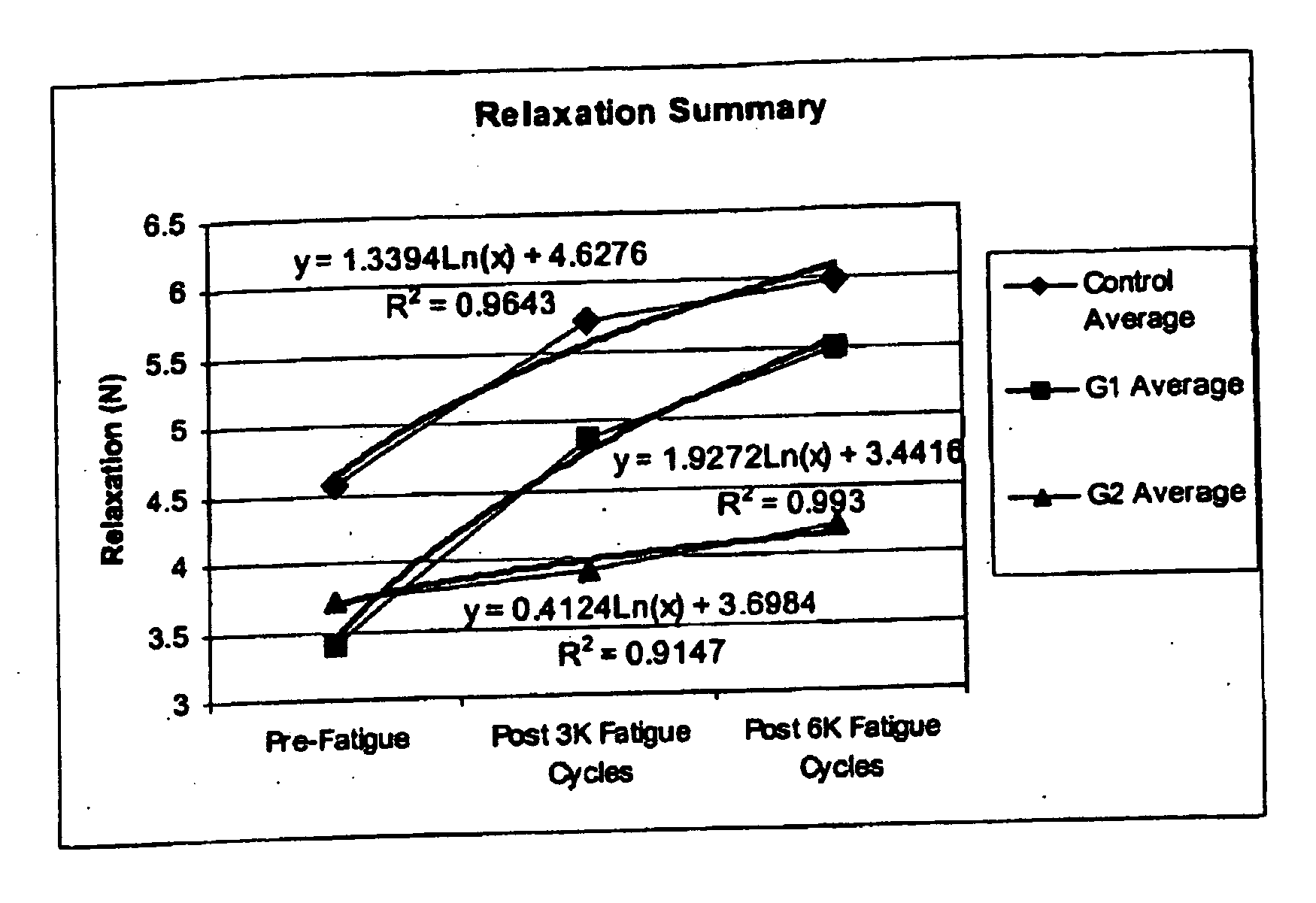Direct application of non-toxic crosslinking reagents to resist progressive spinal deformity
a crosslinking reagent and non-toxic technology, applied in the field of tissue treatment, can solve the problems of reducing the ability of cells to repair mechanical damage to the matrix, and failing to reach the original ultimate stress level, so as to improve the resistance to deformity-increasing bending and strength. , the effect of increasing the bending stiffness
- Summary
- Abstract
- Description
- Claims
- Application Information
AI Technical Summary
Benefits of technology
Problems solved by technology
Method used
Image
Examples
examples 1 and 2
[0065] Thirty-three lumbar intervertebral joints were obtained from ten four-month-old calf spines. The intervertebral joints were arbitrarily divided into 3 groups: untreated controls—12 specimens, Genipin treatment 1 (G1)—6 specimens, and Genipin treatment 2 (G2)—13 specimens. The G1 treatment involved 72 hours of soaking the whole specimen in PBS with a 0.033% concentration of Genipin. Similarly the G2 treatment involved 72 hours of soaking whole specimens in PBS with 0.33% concentration of Genipin. 0.33% Genipin in PBS is produced by dilution of 50 ml of 10 times. PBS (Phosphate Buffered Saline) with distilled water by a factor of 10 to give 500 ml (500 gm) of PBS and mixing in 1.65 grams of genipin to produce the 0.33% (wt %, gm / gm) solution. Previous testing with pericardium and tendon tissue samples demonstrated the reduction of tissue swelling (osmotic influx of water into the tissue) resulting from crosslinking the tissue. Some controls were not subjected to soaking prior t...
examples 3 and 3a
[0077] Experiments were conducted to evaluate the efficacy of applying different formulations of crosslinking reagents with known minimal cytotoxicity unilaterally to intervertebral disc annular tissue in order to affect the lateral bending stability of the tissue compared to pre-treatment.
[0078] Experiments utilized 5 calf spine segments, each segment comprised of 3 lumbar intervertebral joints (motion segments), four vertebrae and the intervening 3 discs. The pedicles were cut and the posterior processes removed. The segments were randomly divided into a 0.33% by weight genipin crosslinked group, a 0.5% genipin group, a 0.66% genipin group, and a 0.66% genipin plus 0.1% proanthocyanidin group. Each group consisted of one 3 motion segment specimen. Each pre-treated spine served as its own control. Repeated testing was performed on some untreated and treated specimens to determine repeatability of the measurements. Additional appropriate concentrations and combinations of known min...
example 4
[0084] By measuring the change in hydration of different regions of the intervertebral disc (nucleus pulposus, inner annulus, and outer annulus fibrosus) prior to and after periods of soaking, sustained compressive loading, and resoaking, the fluid flux to and from different regions can be determined. By comparing these measurements between control discs and discs treated with crosslinking reagents known to have minimal cytotoxicity, we see the effect of crosslinking treatment on fluid flux and permeability.
[0085] A total of 24 calf (4 month old bovine) intervertebral discs were used for this study. Water content of three different areas of the discal tissue were tested—the nucleus pulposus, inner annulus fibrosus and outer annulus fibrosus. Hydration change was determined by weighing the specimen using a micro-balance (sensitivity: 0.1 mg). Water content (M) was calculated as:
M=(Wet Weight−Dry Weight) / Wet Weight=gH2O / g Wet Weight
[0086] The drying procedure consisted of putting t...
PUM
| Property | Measurement | Unit |
|---|---|---|
| time | aaaaa | aaaaa |
| total volume | aaaaa | aaaaa |
| total volume | aaaaa | aaaaa |
Abstract
Description
Claims
Application Information
 Login to View More
Login to View More - R&D
- Intellectual Property
- Life Sciences
- Materials
- Tech Scout
- Unparalleled Data Quality
- Higher Quality Content
- 60% Fewer Hallucinations
Browse by: Latest US Patents, China's latest patents, Technical Efficacy Thesaurus, Application Domain, Technology Topic, Popular Technical Reports.
© 2025 PatSnap. All rights reserved.Legal|Privacy policy|Modern Slavery Act Transparency Statement|Sitemap|About US| Contact US: help@patsnap.com


